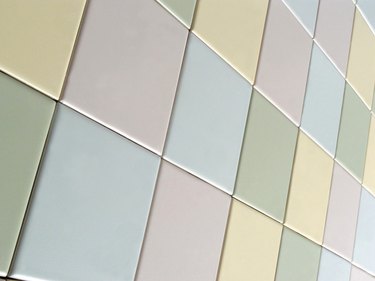
Many homes use ceramic tile in the kitchen and bathroom, as a decorative trim in living room spaces and as part of fireplace surrounds. Tile can last a long time and some colors can seem outdated quickly. Painting your tile can modernize it without the need for replacement. Painted ceramic tiles also make excellent art pieces. However, few paints adhere well to glazed tile. Use the right type of paint and the correct technique to ensure that your painted tiles stay beautiful.
Spray Paint
Video of the Day
Spray paint works on glazed ceramic objects such as lamps and individual tiles. It may also adhere to tiled walls, though it coats the grout and can scratch or peel with rough handling. "Real Simple" magazine recommends using "fusion"-type paints meant for painting plastic and other slick surfaces. This reduces the risk of poor adhesion and peeling later. Regular spray paint over primer may work, but has a greater risk of cracking or sticking unevenly. Make sure the tile is clean and dry before painting since dirt or water can cause bubbles and other imperfections.
Video of the Day
Ceramic Paints
Oven-baked ceramic paints do best on individual tiles used as art objects. These water-based paints go on easily and dry within 24 hours. However, they don't adhere completely until they are baked in an oven at a temperature of several hundred degrees. Clean the finished tile using warm soapy water, but never scour it, as this can remove the paint.
Oil-Based Paint
Oil-based paints stick to ceramic tile that doesn't get wet often. Prepare the tile by cleaning it and any surrounding grout thoroughly. Then brush or roll the paint onto the tile, masking off other surfaces you don't want painted, when necessary. Oil paint works with stencils or freehand patterns. Allow the paint to dry with good ventilation for two to three days, then coat the tile with two coats of water-based urethane varnish. Avoid oil-based varnishes that can yellow over time. The urethane finish makes oil-painted ceramic tile suitable for use on walls, dry counters and even floors.
Latex and Acrylic Paint
These easy-to-apply water-based paints don't make the best tile paints. Acrylic and latex paints tend to peel away from tile easily, especially when used in wet areas or places where they'll suffer abrasion or impact. However, latex paint will work on tile when applied in several thin coats and coated with a durable varnish. Acrylics work best for art tiles, and then only when modified using a special glass and tile medium available from most craft stores. Glaze the finished tile with more medium to protect the design, and allow the tile to cure for two weeks or more.
Epoxy Paint
This high-end, durable paint can be difficult to apply, but forms a very sturdy coating, even on glazed ceramic. Epoxy paint resists heat and chipping very well, and stands up to water, acids and alkaline materials better than most paints. This makes it the material of choice for painting tile in bathrooms, kitchens and other high-wear areas. However, this paint can lose its looks over time, especially when exposed to harsh conditions. It may lose gloss and color through a process known as "chalking." Apply epoxy paint only to very clean surfaces and work quickly. Epoxy cures through a chemical reaction, and can set up before the paint job is done.
- “Real Simple”; Ceramic or Glass Lamps and Paper or Fabric Shades; Sarah Engler et al
- Homecrafts Direct: Ceramic Painting
- Ask the Builder; Painting Ceramic Tile; Tim Carter
- Apartment Therapy; How To: DIY Paint Ceramic Tile; Gregory Han, November 2008
- Hoffman: Materials and Paint Finishes
- Plaid: What are Some Tips for Painting on Glass and Glazed Ceramic...
- Fern Creek Cottage: Spray Painting Ceramics Tutorial